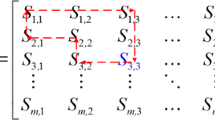Abstract
The manuscript presents the construction of a diagonally structured Parity check matrix using lower and upper (LU) decomposition for regular Quasi Cyclic-Low Density Parity Check Codes (QC-LDPC) with girth 12. This diagonally structured parity check matrix reduces the sparsity characteristics of QC-LDPC codes. The regular Quasi Cyclic-LDPC code has been constructed using circulant shifting and randomization method in which uniform distribution of non-zero elements, XOR operation, and pairing of row and column has been done. A Simplified Log Domain Sum-Product Algorithm (SLDSPA) is used for the decoding of the constructed code. To reduce the CPU run time of the constructed code, a column-wise loop optimization technique is applied. The frame error rate and CPU run time is calculated for different code lengths such as code1 (816, 408), code2 (1008, 504), code3 (1032, 516), code4 (1944, 972), code5 (672, 336) and code6 (504, 252). The construction of regular QC-LDPC codes on half code rate is obtained for the weight of each row is 6 and each column is given by 3. The results showing that the constructed code is better performing in terms of Low FER (10−1 to 10−7), Low SNR (0 to 3.5 dB) and Less CPU run time in milliseconds.








Similar content being viewed by others
References
Wymeersch H, Steendam H, Moeneclaey M (2016) Log domain decoding of LDPC codes over GF (q). In: Proceedings of IEEE international conference on communications, vol 2, June 2004, pp 772–776
Xu J, Chen L, Djurdjevic I, Lin S, Abdel-Ghaffar K (2007) Construction of regular and irregular LDPC codes: geometry decomposition and masking. IEEE Trans Inf Theory 53(1):121–134
He Z, Roy S, Fortier P (2007) Lowering error floor of LDPC codes using a joint row-column decoding algorithm. In: Proceedings of IEEE communications society (ICC 2007)
Zhang J, Zhang G (2014) Deterministic girth eight QC-LDPC codes with large column weight. IEEE Commun Lett 18(4):656–659
Yang P, Bao X, Zhao H (2013) Construction of quasi-cyclic LDPC codes with large girth based on circulant permutation matrix. In: IEEE conference
Wang L, Zhang X, Yu F, Fu Y, Wang Y (2013) QC-LDPC codes with girth eight based on independent row-column mapping sequence. IEEE Commun Lett 17(11):2140–2143
Gholami M, Samadieh M, Raeisi G (2013) Column-weight three QC LDPC codes with girth 20″. IEEE Commun Lett 17(7):1439–1442
Zhang L, Li B, Cheng L (2015) Construction of type-II QC LDPC codes based on perfect cyclic difference set. Chinese Journal of Electronics 24(1):146–151
Vafi S, Majid NR (2016) Half rate quasi cyclic low density parity check codes based on combinatorial designs. Journal of Computer and Communications 4:39–49
Islam MR, Shafiullah DS, Faisal MMA, Rahman I (2011) Optimized min-sum decoding algorithm for low density parity check codes. Int J Adv Comput Sci Appl (IJACSA) 2(12):168–174
Zhang G (2016) Type-II quasi-cyclic low-density parity-check codes from Sidon sequences. Electron Lett 52(5):367–369
Liu Y, Zhang M, Niu X (2016) Quasi-cyclic low-density parity-check codes based on progressive cycle growth algorithm. In: 2016 Sixth international conference on instrumentation & measurement, computer, communication and control (IMCCC)
Chang TCY, Su YT (2017) Adaptive group shuffled decoding for LDPC codes. IEEE Commun Lett 21(10):2118–2121
Uchoa AGD, de Lamere RC (2017) Coding techniques for future Wi-Fi. Elsevier J 8:1–15
Abdu-Aguye U-F, Ambroze MA, Tomlinson M (2016) An efficient algorithm for determining the girth and ACE distributions in LDPC code tanner graphs. In: 2016 10th International conference on signal processing and communication systems (ICSPCS), vol 14(8), December 2016
Author information
Authors and Affiliations
Corresponding author
Additional information
Publisher's Note
Springer Nature remains neutral with regard to jurisdictional claims in published maps and institutional affiliations.
Rights and permissions
About this article
Cite this article
Mathur, J.P.S., Pandey, A. FER Performance Analysis and Optimization of Diagonal Structure Based QC-LDPC Codes with Girth 12 Using LU Decomposition. J. Electr. Eng. Technol. 15, 1405–1412 (2020). https://doi.org/10.1007/s42835-020-00394-w
Received:
Revised:
Accepted:
Published:
Issue Date:
DOI: https://doi.org/10.1007/s42835-020-00394-w




